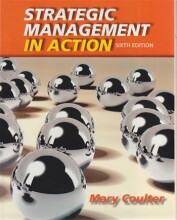Summary: Strategic Management In Action | 9780132620673 | Mary Coulter
- This + 400k other summaries
- A unique study and practice tool
- Never study anything twice again
- Get the grades you hope for
- 100% sure, 100% understanding
Read the summary and the most important questions on Strategic Management in Action | 9780132620673 | Mary Coulter
-
1 Introducing the concepts
This is a preview. There are 4 more flashcards available for chapter 1
Show more cards here -
What is Process of SM?
- Situation analysis - scanning and evaluating current org. context, external environment and org. environment
- strategy formulation - developing and choosing appropriate strategies
- strategy implementation - putting strategies into action
- strategy evaluation - of the outcomes of strategies and how been implemented and eventually need to be modified
- Situation analysis - scanning and evaluating current org. context, external environment and org. environment
-
Name Four characteristics SM
- by nature interdisciplinary- no focus specific area organisation
- External focus, it involves interaction of organisation with external environment (economy, competitors demographics)
- Internal focus, the organisations' resources and capabilities resources does or does not have and capabilities what it does well or not
- the future direction of organisation: weekly plan, yearly financial planning, long-term planning shifts products and services (BMW 3 year Apple 1 year)
- by nature interdisciplinary- no focus specific area organisation
-
what is strategy formulation - name 3 types of strategies
strategy formulation is developing and choosing appropriate strategies (as guided by results of situation analysis) we can define 3 strategies:- functional strategies (operational) goal-directed plans and actions for org. functional areas as sales & marketing, R&D, HR, IS, Finance
- Competitive strategies (business) goal-directed plans and actions how the organisation can compete in specific business or industry. It addresses the competitive advantages an organisation wants to develop
- corporate strategies are goal-directed plans and actions with choices what business to be in and what to do with that business
-
Process researchers vs Content researchers
Process researchers focus on the "how" the strategy is formed - the process
Content researchers focus on trying to understand the relationship between strategic decisions and organisational performance "what" -
Name the 3 groups in strategic management process
- Board of directors
- top management CEO
- Managers and org. employees
-
what is a vision? what is mission?
Vision: a standard of behaviour, org. values, what org. believes in and wants to become (purpose)
Mission: what org. units do (to achieve the vision) -
2 Managing strategically
This is a preview. There are 15 more flashcards available for chapter 2
Show more cards here -
Industrial organisation view I/O vs Resource-based view, Guerrilla view what is it?
- I/O view organisation looks at impact of external factors
- The resource-based view is exploiting org. resources (internal) in order to develop and maintain a competitive advantage
- Guerilla view - org. competitive advantage is temporary and can be gained by rapid radical surprises in the marketplace
- I/O view organisation looks at impact of external factors
-
The Industrial org. view - describe it
The I/O view has an external focus, at industry level, focus on structural forces within industry, competitive environment of firms, and how these influence the competitive advantage. Important is understanding what makes industry attractive in which to compete and choosing competitive positioning -
Describe the types of org. resources
- Financial resources: cash, debt, equity, profits
- physical resources -buildings, land, factories
- human resources - human resources, knowledge, skills
- intangible resources: patents, trademarks, brand, reputation
- structural/cultural resources: org. culture, work systems, policies. org. structure, relationships
-
RBV defines resources must be unique and source of competitive advantage, what are the four characteristics for sustainable competitive advantage?
- Value: org. resources are Valuable when they Exploit external opportunities and or Neutralise threats
- Rarity - ideally no competing firm should have it
- Hard to imitate and substitute - specific resource is hard to copy or alternative resource for it
- Ability to exploit it: exploit to full competitive advantages of its resources
- Higher grades + faster learning
- Never study anything twice
- 100% sure, 100% understanding
































